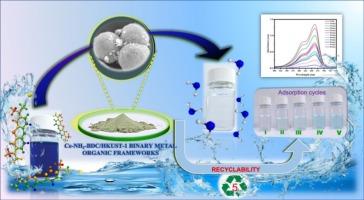基于Ce-NH2-BDC/ hkust -1的二元金属有机框架,可高效吸附亚甲基蓝
IF 5.2
2区 化学
Q2 CHEMISTRY, PHYSICAL
引用次数: 0
摘要
以1,3,5-苯三羧酸和2-氨基对苯二甲酸为配体,合成了铈铜基二元金属有机骨架(MOFs),简称Ce-NH2-BDC/HKUST-1,简称CCB-MOFs,用于去除水溶液中的亚甲基蓝(MB)。尖锐而强烈的衍射峰证实了CCB-MOF的结晶性质。利用FT-IR对CCB-MOF的化学结构和官能团进行了表征。CCB-MOF的扫描电镜图像显示为球形形貌,表明Ce-MOF在Cu-MOF之上形成了一层。x射线光电子能谱分析证实了合成的二元MOF中存在金属节点和有机连接体。brunauer - emmet - teller分析表明,CCB-MOF的表面积为52.36 m2 g−1。对MB染料在CCB-MOF上的吸附性能进行了研究,结果表明,在pH为7、接触时间为60 min、环境温度下,MB染料的最佳去除率约为98%。吸附等温线符合线性Langmuir等温线模型,吸附动力学用拟二级动力学模型描述。Langmuir等温模型估计CCB-MOF对MB染料的最大吸附量可达172.41 mg g−1。实验结果表明,甲基溴染料在CCB-MOF上的吸附主要是由CCB-MOF与甲基溴染料之间的静电吸引作用驱动的。本研究为开发ccb - mof基吸附剂从水溶液中回收MB染料提供了新的思路。本文章由计算机程序翻译,如有差异,请以英文原文为准。

Ce-NH2-BDC/HKUST-1-based binary metal–organic frameworks enabling efficient adsorption of methylene blue
Cerium–copper-based binary metal–organic frameworks (MOFs), referred to as Ce-NH2-BDC/HKUST-1, abbreviated as CCB-MOFs, were synthesized using 1,3,5-benzenetricarboxylic acid and 2-aminoterephthalic acid ligands for the removal of methylene blue (MB) from aqueous solutions. The sharp and intense diffraction peaks confirm the crystalline nature of the CCB-MOF. The chemical structure and functional groups of CCB-MOF were examined through FT-IR analysis. The scanning electron microscope image of CCB-MOF shows a spherical morphology and indicates that Ce-MOF forms a layer on top of Cu-MOF. X-ray photoelectron spectroscopy analysis confirms the presence of metal nodes and organic linkers in the synthesized binary MOF. Brunauer–Emmett–Teller analysis reveals that CCB-MOF possesses a surface area of 52.36 m2 g−1. The study on the adsorption properties of MB dye on CCB-MOF demonstrated that the optimum dye removal efficiency of approximately 98 % was achieved at pH 7, a minimal contact time of 60 min, and ambient temperature. The adsorption isotherm fitted the linear Langmuir isotherm model, and the kinetics of the adsorption was described by the pseudo-second-order kinetic model. The maximum MB dye adsorption capacity of CCB-MOF estimated by the Langmuir isotherm model was up to 172.41 mg g−1. The experimental results demonstrate that the adsorption of MB dye on CCB-MOF is primarily driven by electrostatic attraction between CCB-MOF and the MB dye. This study provides new insights into developing CCB-MOF-based adsorbents for recovering MB dye from aqueous solutions.
求助全文
通过发布文献求助,成功后即可免费获取论文全文。
去求助
来源期刊

Journal of Molecular Liquids
化学-物理:原子、分子和化学物理
CiteScore
10.30
自引率
16.70%
发文量
2597
审稿时长
78 days
期刊介绍:
The journal includes papers in the following areas:
– Simple organic liquids and mixtures
– Ionic liquids
– Surfactant solutions (including micelles and vesicles) and liquid interfaces
– Colloidal solutions and nanoparticles
– Thermotropic and lyotropic liquid crystals
– Ferrofluids
– Water, aqueous solutions and other hydrogen-bonded liquids
– Lubricants, polymer solutions and melts
– Molten metals and salts
– Phase transitions and critical phenomena in liquids and confined fluids
– Self assembly in complex liquids.– Biomolecules in solution
The emphasis is on the molecular (or microscopic) understanding of particular liquids or liquid systems, especially concerning structure, dynamics and intermolecular forces. The experimental techniques used may include:
– Conventional spectroscopy (mid-IR and far-IR, Raman, NMR, etc.)
– Non-linear optics and time resolved spectroscopy (psec, fsec, asec, ISRS, etc.)
– Light scattering (Rayleigh, Brillouin, PCS, etc.)
– Dielectric relaxation
– X-ray and neutron scattering and diffraction.
Experimental studies, computer simulations (MD or MC) and analytical theory will be considered for publication; papers just reporting experimental results that do not contribute to the understanding of the fundamentals of molecular and ionic liquids will not be accepted. Only papers of a non-routine nature and advancing the field will be considered for publication.
 求助内容:
求助内容: 应助结果提醒方式:
应助结果提醒方式:


